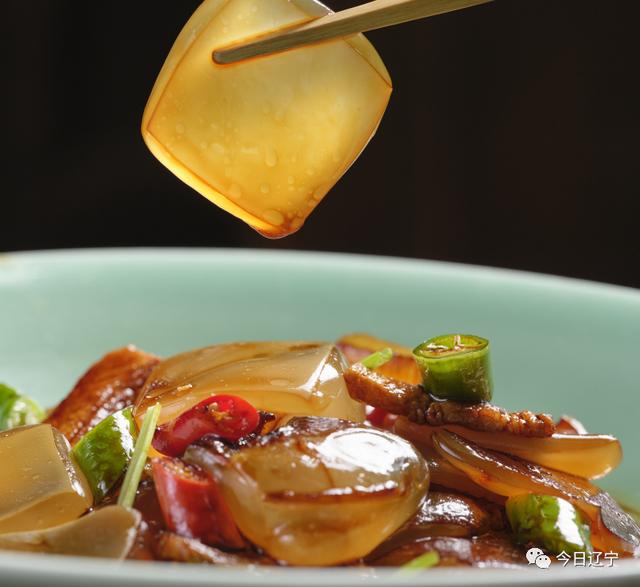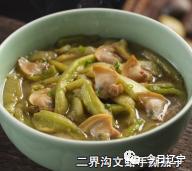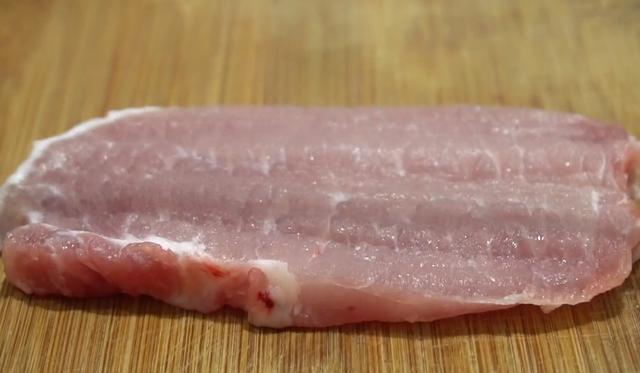渔家码头的特色菜(走向世界的辽河口渔家菜)

在拥有中国最北海岸线的盘锦,说起美食,可谓数不胜数。可在这个美食之乡,近年来辽河口渔家菜却大出风头,2020年,不仅入选了辽宁省人民政府发布的第六批省级非物质文化遗产代表性项目名录,还成为全球首家米其林东北菜。
而2021年更是走出中国,走向世界,在10月29日由亚太地区非物质文化遗产国际信息和网络中心主办的“2021年海洋遗产网络建议专家会议”上,辽河口餐饮文化发展研究会会长、辽河口渔家菜非遗传承人、盘锦福德汇餐饮有限公司董事长张嵩参与“关于沿海饮食非遗保护专项论坛”并作主旨发言,对以辽河口渔家菜为代表的辽河口海洋文化资源“生产性保护,文创化传播,产业化传承”的理念和取得的成绩进行了介绍,得到了与会者的高度认可。

二界沟绵海蜇烧肉

如今,辽河口渔家菜成了盘锦美食文化走出去的一个样本,成了弘扬盘锦、宣传盘锦的一块对外金字品牌!
联合国教科文组织会议辽河口渔家菜大放异彩
2021年10月29日,由联合国教科文组织主办、联合国教科文组织亚太地区非物质文化遗产国际信息与网络中心(ICHCAP)和太平洋共同体(SPC)协办的“2021海事非物质文化遗产网络建设专家论坛”在韩国首尔举办。来自联合国教科文组织的有关负责人以及亚洲沿海区域的斐济、孟加拉国、菲律宾、韩国、印度、越南、印度尼西亚等国家的9位专家、学者和非遗保护组织负责人、非遗传承人以视频方式在论坛上分享了各种案例,由中华美食文化发展促进联盟经遴选推荐的张嵩在论坛第一次会议上发表了标题为《中国辽河口特色海洋食材与民间食俗的餐饮生产性保护》的演讲,介绍了中国辽河出海口地区自然资源的多样性、相关习俗的源远流长以及餐饮生产性保护成果和发展规划。
渔家坚果黑豆腐

据了解,来自中国海洋非遗保护一线的传承人代表还是首次参加此类国际论坛并发言。今年4月,联合国教科文组织编辑出版了此次论坛论文专辑,张嵩的《中国辽河口特色海洋食材与民间食俗的餐饮生产性保护》演讲文稿被收入专辑。
非遗美食辽河口渔家菜为什么会受到国际关注
对于非遗美食辽河口渔家菜为何受到国际关注,国家级非遗-中国烹饪技艺与食俗项目保护代表人、清华大学文化创意研究院特约研究员、中华美食发展促进联盟理事长边疆告诉本刊记者,曾经从事教育与文史工作的张嵩和同是辽河口渔家菜非遗传承人的辛亚萍以对传统文化的热情和企业家的报国情怀带领福德汇餐饮公司经过多年的挖掘整理,梳理复原了辽河口渔家菜体系,从民间喜爱的食材到技艺完整的烹饪方法;从流行民间的餐厨用具到源远流长的饮食习俗,广泛收集、精炼提取,完整地复原了这个几乎被淹没在民间的文化体系,在有关政府部门的支持下,辽河口渔家菜进入省级非遗保护项目。福德汇也因注重传统文化传播而被称为“建在博物馆里的餐厅”。福德汇餐饮公司的贡献不仅在于以企业人力物力财力主动投入非遗保护工作,更在于用餐饮企业运行对非遗项目进行了生产性保护,使其获得新的活化。随着福德汇事业在全国各地的拓展,辽河口渔家菜在各地开花结果形成更为广泛的传播。

辽河口渔家菜


辽宁大学教授、中国民俗学会副会长、国家非物质文化遗产保护专家委员会成员江帆认为,辽河口渔家菜生动地诠释了这一富有特色的东北亚河海口食材文化及餐饮传统在当代的活态传承,包括辽河口餐饮食俗在内的辽河口文化以族群记忆的方式对区域与族群的历史予以了“建档”和“存档”,其所蕴含的河海口文化质素,在倡行文化多元化的今天尤显珍贵。
辽河口文化研究会会长杨洪琦说,直接或间接取自民间的食材食艺,构筑了辽河口渔家菜的基石。辽河口渔家菜的食材构成是相对稳定的,即海鲜、河鲜、湿地物产。不过作为辽菜的一个分支,它并非一个封闭的系统,而是一个开放的体系。具体说,辽河口渔家菜并不会落实为一张一成不变的固定菜谱,而是会随着对地域食材的不断整合利用,对传统食艺的持续发现发掘,随时随地进行增补,它所含纳的菜品会呈现一个愈趋丰满的动态过程,尽管它目前就已经很丰富了。地域的独特性决定了食材的独特性,也最终决定了人们独具特色的饮食结构和口味倾向。这样的食俗始终都被盘锦这片土地上的居民默默延续,辽河口渔家菜不过是对这种饮食文化进行了概括。作为地域文化的一个重要构成,饮食文化的代表性符号由此得以确立,这无疑将使盘锦的城市文化特质更趋鲜明,接下来的文化发展朝向也将更为明朗。
优越独特的地理环境造就了辽河口渔家菜
辽河口渔家菜起源于盘锦,是辽河口三角洲地区(辽河、大辽河、大凌河入海口)的地域特色菜品,是辽河民间菜的组成部分,其特点为四季分明、食俗互动、民俗融合、餐酒搭配。辽河口渔家菜取材于辽河流域的河鲜、江鲜、湖鲜、渤海湾的海鲜,及当地的山珍野蔬,以当地渔民的地道做法烹制而成。
辽河口渔家菜的形成,离不开其优越而独特的地理位置。辽河口三角洲为中国四大河口三角洲之一,位于盘锦市境内。拥河傍海的地理环境、独有的河口自然资源孕育了鲜明的辽河口地域文化,四季分明的气候让这里的食材时令性特征明显,储存方式多样。冷水海域的环境让这里的海产味道鲜美,肉质饱满;海河交汇的位置让这里的水成为“两合水”,盐度不浓不淡,水温不高不低,水流不急不缓,水质不混不浊。同时,这里也是退海之地,滩涂淤泥遍布,蛤、鱼、虾、蟹等近海海产肥厚鲜美,地下盐卤资源丰富,井盐、海盐并存。

辽河民俗博物馆传承、推广、发展辽河口渔家菜
2007年,张嵩和辛亚萍创立了盘锦福德汇文化传播发展有限公司,开始了寻找辽河口美食文化之旅。
为了提炼出辽河口渔家菜的文化之魂,十余年来,作为辽河口渔家菜第四代传承人,除了师承外,张嵩、辛亚萍和他们的团队还在盘锦走进民间、遍访名师,寻找那些当地人常年食用却不为外人所知的美味食材,听到哪家的主妇有拿手菜,就要尝上一尝,观摩她们的做法,所谓“不学大师学大妈”。
作为辽河口渔家菜非遗传承人,张嵩和辛亚萍利用20多年的时间收集辽河口地区各种传统的渔猎、农耕生产用具、日常生活用品、餐饮行业用具器皿等民俗老物件,自筹资金建起辽河民俗博物馆,馆内藏品万余件。近年来,辽河民俗博物馆不断拓展辽河口文化业态和围绕辽河口海洋资源的餐饮业态,精心打造民俗博物馆里的餐厅。公司已在沈阳、深圳、北京等地创建了十余家辽河文化博物馆主题餐厅,传承、推广、发展辽河口渔家菜,传播古渔雁文化,打造了辽河文化对外展示的重要窗口,实现了海洋资源从遗产到资源,再从资源到资产的有序转化。
辽河口渔家菜的特色是传统与自然的结合
近些年,以张嵩、辛亚萍为代表的盘锦美食文化专家推出了一系列饮誉国内的盘锦辽河渡口特色菜品。
如稻家私享大米,选用盘锦原生态生长环境产出的蟹田营养米,在同一块稻田里既种稻、又养蟹,形成了“水稻护蟹、蟹吃虫饵、蟹粪肥田”的天然食物链,整个种植过程无农药、无化肥,生态环保,这也成就了光亮透明、色泽均匀、口感柔软、味道清新、营养丰富的蟹田米,配以从日本购进的器皿更突显大米糯而不黏、营养丰富的特点,并登上央视CCTV9《致富经》栏目、央视《稻米之路》,获奖无数。


稻家私享
如“当潮渔获,有啥吃啥”的盘锦一网鲜。张嵩介绍说,所谓“靠山吃山,靠海吃海”,在盘锦二界沟当地,渔民是以捕鱼为生。由于长期出海在外,所以一日三餐也成了渔民生活最重要的一部分,菜品主要以捕捞上来的新鲜鱼虾蟹贝为主。一网抛撒下去,什么海鲜都有,所以,渔民们就把这些刚刚捕捞上来的不同品种的海鲜放在一起去烹饪,其味道鲜美、回味无穷、记忆犹新,后来,就形成了这道家喻户晓的名菜——盘锦一网鲜。盘锦一网鲜浓缩了辽河口地区历时悠久的传统民间饮食文化,传承了北方地区古老的渔家菜制作工艺,讲求即捕即食,最大限度地保持食材本原的营养价值和新鲜味道。如蒲笋,是辽宁唯一入选央视CCTV1《舌尖上的中国Ⅱ》的食材,选自蒲草根部的内芯,每100斤蒲草才能产出3斤蒲笋,同时季节性强,时期短、产量低,其粗纤维丰富,是唯一野生、不可人工种植的食材。
又如文蛤,盘锦二界沟蛤蜊岗涨潮为海,落潮为陆,以盛产“天下第一鲜”文蛤驰名,素有“盘锦文蛤库”之名,被世人誉为“渤海金滩”,此处的文蛤据说被乾隆皇帝御批为“天下第一鲜”。文蛤的钙质含量尤为突出,其中含有的牛磺酸,可以帮助胆汁的合成,有助于胆固醇代谢。这其中,蛤肉水馅包有皮薄馅稀、色白褶匀、油大不腻、滋味鲜美四个特点,水馅包子是东北广为流传的汉族小吃;文蛤手撕茄子的茄子配以文蛤,更能突显蛤蜊的鲜美,其口感滑嫩,汤汁鲜美;文蛤汤不添加任何调味品,最大程度地保持了文蛤本身“鲜美”的金字招牌;原汁烤文蛤的文蛤产自二界沟蛤蜊岗,原汁烤文蛤保留了文蛤的原汁原味。又如芦苇荡野鸭,产自世界最大的芦苇荡辽河三角洲地区,无垠的苇海里栖息着数十万飞禽,由于空气清新,环境安静,使野鸭得以自由活动、戏水、晒太阳,采食大量的天然饲料,从而巧妙地保持其野性本质。
至于漁家坚果黑豆腐,黑豆腐选用优质黑豆与黑芝麻、榛果、核桃等按照一定比例搭配,辽河渡口用古法细细研磨,自制而成,口味醇香,口感滑嫩,同时黑豆具有补肝明目、活血养胃、美容养颜等功效。
本文图片由福德汇文化传播发展有限公司提供
On the morning of October 29, 2021, Zhang Song, the president of the Liaohekou Restaurant Cultural Development Research Association, was invited to participate in the“2021 Expert Meeting on Marine Heritage Network Recommendations”hosted by the International Information and Networking Center for Intangible Cultural Heritage in the Asia- Pacific Region (ICHCAP). During the meeting, Zhang delivered a 15-minute keynote speech to the“Special Forum on Protecting the Intangible Heritage of Coastal Food”. The ICHCAP is a permanent institution working under the auspices of UNESCO. Zhang’s speech is the only speech given by the inheritors of the Liaohekou cuisine on a United Nations platform so far. This speech reflected the philosophy and achievements of Liaohekou fishermen’s cuisine—“productive protection, creative dissemination, and industrial inheritance”—which are highly recognized by the international catering industry.
Today, the cuisine of Liaohekou fishermen has become a model for the globalization of Panjin’s food culture and represents a golden brand to introduce Panjin to the world! The“Liaohekou Fishermen’s Cuisine”, which Zhang Song has worked hard to create, originates from Panjin and is a regional specialty of the delta area of Liaohekou (the mouth of the rivers Liaohe, Daliaohe, and Dalinghe). It is part of Liaohekou folk cuisine.
The Liaohekou fishermen’s cuisine has different specialties in each season and unique wines to accompany them. The cuisine interacts with the locality. The raw materials are river food and lake food from the Liaohekou area. The seafood is from Bohai Bay, while the wild vegetables come from the mountains. These fresh ingredients are cooked according to the authentic recipes of the fishermen. The Liaohekou fishermen’s cuisine would be impossible without its superior and unique geographical location. The Liaohekou delta, located in Panjin City, Liaoning Province, is one of the four major estuary deltas in China. This exclusive geographical location embraces both the river and the sea, and the natural resources unique to the river mouth nurture the Liaohekou regional cuisine. The climate allows for seasonal ingredients to be stored in a variety of ways. The cold-water sea environment makes the seafood taste delicious and succulent. The meeting of the sea and the river makes the local water a perfect combination of contrasting elements—the salinity is neither too concentrated nor too diluted, the water temperature is neither too high nor too low, the current is neither too fast nor too slow, and the water quality is neither too clear nor too turbid. The Liaohekou delta is also a place of receding sea, which is covered by mud and silt. Clams, fish, shrimp, crabs, and other seafood are fat and fresh in the area, and the underground salt and brine resources are abundant, with well salt and sea salt coexisting.
As a modern hub of sea and land exchanges, many kinds of ingredients and production methods converged here and formed several different cuisines. In places near the river bank (Liaohe River, Dailiaohe River, and Daling River), we find the Tangpu and Matou (pond and dock) style. In areas along the Bohai Sea coastline, there is the Chuancai and Wangpu (boat and fish net) style. In places where land transportation (railways and roads) is advanced, we find the Wopu (bistro) style.
Zhang Song, who is good at discovering the tasty local dishes, thinks that Liaohekou fishermen’s cuisine contains culture in every one of its aspects. From the rich and diversified selection of ingredients and distinctive storage methods to the perfect cooking skills, Liaohekou fishermen’s cuisine is the essence of the ancient fishermen’s culinary culture of the northern region. It is the inheritance of the local traditional food culture, which has a long history in Liaohekou. This cuisine’s production methods contain over 30 techniques, including steaming, stirfrying, burning, deep- frying, and braising. It has more than 40 kinds of representative dishes, such as stewed jellyfish and pork and hand- ripped eggplant with clams. Taste is important in this cuisine and is characterized by a preference for freshness. The preparation techniques of the Liaohekou fishermen’s cuisine follow tradition and are adjusted according to different ingredients. The cuisine’s rich and varied dishes are enjoyed by local people and those in the region, and its influence is increasing every day. River crab and tofu is a dish that originated from traditions. Farmers caught a large number of river crabs and carefully selected the crab meat and crab yolk through a dozen processes to create this famous household dish. This dish is tender, unique in flavor, and rich in nutrition. The jellyfish in stewed jellyfish and pork are found in the waters of Bohai Bay. They are a delicious seasonal specialty that is available for consumption only for about 45 days. Therefore, this is a precious dish. It has been featured on the Fortune program of Channel Nine, China Central Television, and has won the title of Famous Dish of Northeast China.
编辑:徐博彦责编:景雪峰,免责声明:本文仅代表文章作者的个人观点,与本站无关。其原创性、真实性以及文中陈述文字和内容未经本站证实,对本文以及其中全部或者部分内容文字的真实性、完整性和原创性本站不作任何保证或承诺,请读者仅作参考,并自行核实相关内容。文章投诉邮箱:anhduc.ph@yahoo.com






